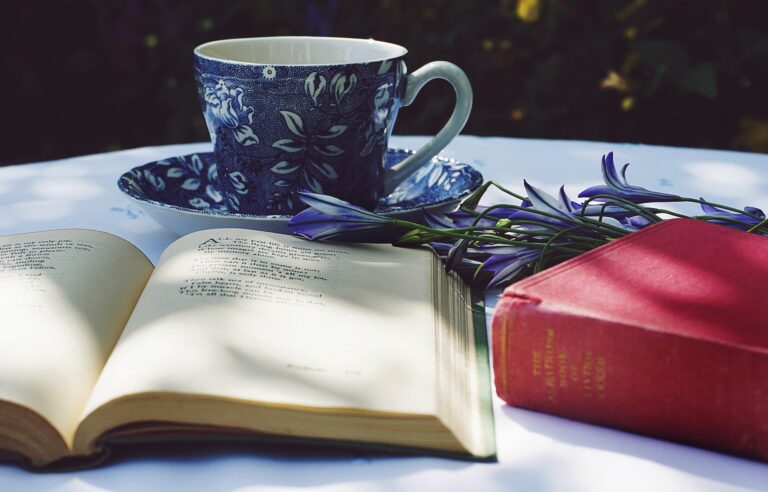Exploring the Use of Allusion in Poetry: Definition and Significance
Ironically, most people tend to shy away from poetry because it seems too complicated or inaccessible. However, the beauty of poetry lies in its ability to touch our hearts and souls with just a few carefully chosen words. One powerful tool poets use to convey complex ideas is allusion – referring to a person, place, event or work of art with which the reader should be familiar.
By evoking shared cultural knowledge and historical context, allusions allow poets to communicate on multiple levels at once. In this article, we’ll delve into what exactly constitutes an allusion in poetry and why it matters so much for both writers and readers alike. Whether you’re new to poetry or a seasoned veteran seeking fresh insights, there’s something here for everyone who wants to explore the magic of literary references!
What Is Allusion?
It is a powerful tool in poetry. It’s the reference to something else, such as an event or person, often used to create meaning beyond what’s on the surface of a poem. With allusions, poets can evoke emotions and ideas beyond their words’ literal meanings.
Allusions are everywhere in literature – from Shakespearean works to modern-day poetry. They allow readers to connect with literary works more deeply by referencing shared cultural knowledge. For example, when a poet references Greek mythology, they’re tapping into centuries-old stories that many people know about.
But allusions aren’t just limited to classic literature; they can be found in everyday life too. From quoting famous movie lines to making jokes about political figures, we use it daily without even realizing it! It adds depth, complexity and interest to language and enhances reading.
What Are The Functions Of Allusion?
Moving on from the definition of allusion, let’s explore its significance and functions in poetry. It is not merely literary devices used for aesthetic purposes; they serve a deeper function that enhances the poem’s meaning and conveys an important message.
- It helps to establish connections between different pieces of literature or cultural references. By referencing well-known works like Shakespeare’s plays or Greek mythology, poets can create a sense of familiarity with their audience and evoke certain emotions associated with those works. This connection adds depth to the poem by drawing upon collective knowledge and experiences.
- It can be used as a tool for irony or satire. A poet may refer to something in popular culture that contradicts the tone or message of their work to emphasize a point or mock societal norms. The use of allusion here is intentional and strategic – it provides an extra layer of commentary on society beyond what could be conveyed solely through words.
- It can help convey complex ideas more effectively by providing context and nuance. Instead of explaining every detail about a particular historical event or figure, it allows the poet to assume some prior knowledge on behalf of their audience while also adding depth to their work.
In summary, understanding the function of allusion in poetry is crucial to fully appreciate its impact on our interpretation and experience of poems. Alluding to other works helps establish connections, adds layers of meaning through irony or satire, and assists in conveying complex ideas with greater efficiency than direct exposition alone would allow.
How Is Allusion Used In Poetry?
Allusion in poetry is a literary device that poets use to create an indirect reference to something outside of the poem. It can be a reference to another work of literature, historical event, or cultural phenomenon. Allusions add depth and complexity to poems and allow readers to connect with the poet’s message on a deeper level.
One way allusion is used in poetry is through references to mythology or religious texts. By referencing these well-known stories, poets can evoke powerful emotions and ideas without having to explicitly state them. For example, T.S. Eliot’s famous poem “The Waste Land” makes numerous allusions to Greek mythology and biblical stories, creating a complex web of meaning for readers to unravel.
Another common use of allusion in poetry is through references to other works of literature. Poets may reference Shakespearean plays, classic novels, or even contemporary pop culture icons in their writing. These references help readers make connections between different pieces of art and deepen their understanding of both the original work and the new piece they are reading.
Allusion in poetry allows poets to convey complex meanings and emotions using relatively few words. Through subtle references to mythology, religion, literature, and popular culture, poets can create multi-layered works that engage readers’ minds and emotions alike. So next time you read a poem, keep an eye out for any hidden allusions – they may just hold the key to unlocking its true meaning!
Examples Of Allusion In Poetry
I’m intrigued by the use of allusion in poetry – it adds depth and meaning to the work. Classical allusions can transport us back in time, showing us how different cultures viewed the world. For example, Homer’s ‘Odyssey’ is often referenced in modern poetry to evoke the feeling of a hero’s journey. Biblical allusions can be used to make a point or draw attention to a moral lesson. For instance, the phrase ‘casting pearls before swine’ refers to the biblical parable of the same name. Cultural allusions can allow us to tap into a shared understanding of a piece of literature. For example, the Dr. Seuss poem ‘Oh the Places You’ll Go’ has become ubiquitous in pop culture. Allusions are powerful tools and when used correctly can make poems more meaningful and memorable.
Classical Allusions
You know what I love about reading poetry? It’s the way poets can use allusions to classical literature and history to add depth and meaning to their words. Take T.S. Eliot, for example. In his famous poem “The Waste Land,” he references ancient Greek mythology, Shakespearean plays, and even Dante’s “Inferno.” By using these classical allusions, Eliot creates a rich tapestry of cultural references that enriches the poem and gives it greater significance.
Classical allusions in poetry are significant because they connect us with our past and help us understand the present. When we read a poem that references Homer’s “Odyssey” or Virgil’s “Aeneid,” we’re reminded of the power of those stories and how they’ve shaped our understanding of human nature. We see ourselves reflected in characters like Odysseus or Aeneas, who struggle against great odds to achieve their goals. And when we encounter those same struggles in our own lives, we draw strength from knowing that others have faced them before us.
But classical allusions aren’t just important for their historical significance and provide poets with a powerful tool for expression. By referencing well-known myths, legends, and literary works, poets can tap into a shared cultural memory that resonates with readers on an emotional level. This is particularly true when it comes to universal themes like love, loss, death, and rebirth – subjects that artists have explored throughout the ages. Whether you’re reading Shakespeare or Sylvia Plath, you’ll find that classical allusions bring new layers of meaning to every line.
Biblical Allusions
You know what I find fascinating about poetry? It’s the way poets use allusions to connect their work with cultural and historical references. One of the most powerful forms of allusion is the biblical allusion, which can be found in many famous poems throughout history. As a reader, encountering these allusions adds depth and layers of meaning to the words on the page.
Biblical allusions are particularly significant because they draw from one of the most iconic texts in human history – the Bible. From Adam and Eve in Genesis to Jesus’ crucifixion in the New Testament, there are countless stories and characters that have become deeply ingrained into our culture over time. When poets reference these tales, they tap into a shared reservoir of knowledge that readers will instinctively recognize. These allusions create a sense of familiarity that makes it easier for us to connect emotionally with what we’re reading.
One example of this is John Milton’s epic poem ‘Paradise Lost,’ which draws heavily from biblical themes and motifs. By referencing figures like Lucifer or Adam, Milton creates a world that feels both familiar and fantastical at once. He uses these allusions to explore complex ideas about morality, free will, and redemption. This is just one instance where biblical allusions enrich a piece of literature beyond measure – creating connections between past and present while also exploring timeless themes that still resonate with us today.
Cultural Allusions
You know what I love about poetry? Its ability to transport readers to different worlds and times through the use of allusions. One type of allusion that never fails to catch my attention is cultural allusions, which refer to elements from various cultures – including literature, history, art, and mythology – that have become widespread in our collective consciousness.
Cultural allusions are fascinating because they draw on a wealth of shared knowledge that spans across countries and generations. For instance, when a poet references Greek myths like Medusa or Narcissus, readers can tap into their prior understanding of these characters’ stories without needing an explanation. This creates a sense of belongingness and inclusivity, as if we’re part of an exclusive club that has access to insider jokes.
What’s more interesting is how poets use cultural allusions not only for effect but also for commentary. By referencing historical events or literary works in their poems, they can offer alternative interpretations or critiques that challenge established beliefs. In doing so, they enrich both the poem itself and the culture it represents by inviting readers to question what they think they know. It’s this kind of intellectual stimulation that keeps me coming back to poetry time and again!
The Impact Of Allusion In Literature
Allusion in literature can have a significant impact on the reader. It is a powerful tool writer use to evoke emotions, create imagery and connect with readers. Allusions are references to people, events or literary works well-known in culture and history. The writer uses these allusions to add depth and meaning to their work.
When an author employs allusion in literature, it creates a sense of familiarity for the reader. As they recognize the reference being made, it allows them to feel more connected to the story as if they are part of a shared experience. This connection helps build trust between the author and the reader, leading to a better understanding of the themes presented in work.
Furthermore, allusion in literature can also provide layers of complexity within a piece of writing. When used effectively by skilled writers, it can elevate a simple story into something profound and thought-provoking. By drawing upon familiar cultural touchstones such as mythology or religion, authors can explore important ideas while avoiding lengthy explanations that might detract from the narrative’s flow.
Incorporating it in literature is not just about creating clever wordplay but rather using cultural knowledge to enhance storytelling. Readers who understand these references will be able to appreciate and engage with books at deeper levels than those who do not. Ultimately, this makes reading both an enjoyable escape from reality and an opportunity for personal growth through learning new things without even realizing it!
How To Recognize Allusion In Text
How can we recognize allusions in the text? Let me share with you a personal story to illustrate this metaphor.
Growing up, my grandmother used to tell me stories about Greek mythology. One of my favorites was the tale of Narcissus, who fell so deeply in love with his reflection that he wasted away and transformed into the narcissus flower. Years later, when I read T.S. Eliot’s “The Waste Land,” I recognized his reference to Narcissus as an allusion that added depth and complexity to the poem.
Here are some tips for recognizing allusion in text:
- Pay attention to references outside of the immediate context.
- Look for connections between characters or themes from different works.
- Consider cultural or historical knowledge that may inform the author’s use of allusion.
- Note any language or phrasing that seems out of place or significant.
- Use resources like footnotes or annotations to aid your understanding.
By following these guidelines, you can unlock the layers of meaning within a piece of writing. Allusion is one tool writers use to enhance their work and create deeper connections with readers. Keep an eye out for it next time you’re reading something new!
Its Significance In Modern Literature
Allusion is not just a tool for poets to show off their knowledge of literature and history. It’s an essential element in modern literature that adds depth, complexity, and meaning to the text. Through allusions, writers can connect with readers on multiple levels by referencing shared cultural experiences or tapping into universal themes.
Allusion has become even more significant in today’s world, where information is readily available at our fingertips. Writers can assume that their audience shares a common knowledge base and use allusions as shorthand to convey complex ideas or emotions without explaining them fully. Allusions also create a sense of continuity between different works of literature, building upon the collective cultural memory.
But perhaps most importantly, allusion allows us to see ourselves reflected in literature. By drawing from familiar stories or historical events, writers can hold up a mirror to society and comment on current issues or attitudes. Allusions remind us of our past while inviting us to examine our present and consider what kind of future we want to build together.
Conclusion
In conclusion, allusion in poetry is a powerful tool used by poets across cultures and time periods. It adds depth to the meaning of a poem and allows for multiple interpretations. As someone who loves poetry, I find it fascinating how a single reference can evoke so much emotion and understanding.
However, some may argue that allusions can be exclusive or alienating to readers who are unfamiliar with the referenced work. While this is a valid concern, I believe it is up to the poet to balance making their work accessible while still utilizing allusions effectively. Ultimately, when used correctly, allusion enhances the richness and complexity of poetry and invites readers to delve deeper into its layers of meaning.




